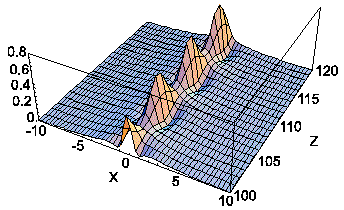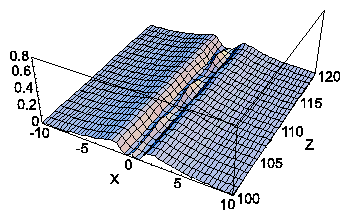|
A quantum mechanical description of channeling under the influence of
ultrasound (US) excited in a single crystal has been developed [1-2].
It was shown that a resonant interaction between a longitudinal standing
ultrasonic wave and planar or axially channeled relativistic charged
particles can take place if the frequency of US approaches some critical
value. This value corresponds to the energy difference between two
neighbouring states a and b of transverse motion. The quantum numbers N
of these states obey the selection rules
| Na-Nb | = 1, 2, 3... for axial
and | Na-Nb | = 2, 4, 6... for planar channeling.
where e denotes the corresponding energy level of the channeled
particle and vs the velocity of US inside the crystal.
Since the effect resembles a parametric resonance, an integer n = 1, 2... appears in the denominator of the formula. This is of great practical importance because it opens the possibility of resonant interaction even at frequencies ns lower than typically 10 GHz for n = 1. At the same amplitude of crystal potential modulation, higher values of n, of course, diminish the effect of US.

Fig. 1 Probability distribution P(X,Z) of a planar channeled electron at resonance (ns = n1*).

Fig. 2 The same as in Fig. 1 but slightly out of resonance (ns = 0.95 n1*). 1 Institute of Applied Problems in Physics, NAS Yerevan, Armenia
References
[1] L.Sh. Grigoryan et al., Rad. Eff. & Def. in Sol. 152 (2000) 225; ibid. p. 269
[2] L.Sh. Grigoryan et al., Rad. Eff. & Def. in Sol. 153 (2000) 13
|